9 Water, Water, Everywhere
Posted by Christine on Sep 12, 2014 in Ireland | 6 comments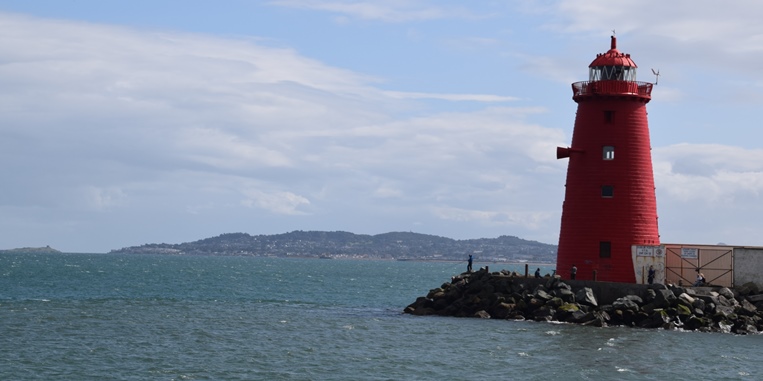
Having grown up on Lake Michigan and spent part of every summer on a lake in the Northwoods, I love living near water and have often said that the only thing wrong with Atlanta is its lack of a waterfront.
Here in Dublin, there’s water everywhere, and we live right where it all converges: the rivers (Liffey and Dodder), the canals (Grand and Royal), and of course Dublin Bay and the Irish Sea, which are close enough to see from the roof of our building. Pretty much in any direction you walk—and in any weather—there’s a sparkle, a glimmer, a flash of the “greeny…stilly” from some body of water or other. On past visits I’ve stayed near the city centre, landlocked by historic buildings, swirling traffic, and masses of pedestrians, with the occasional hurried crossing of the Liffey on my way somewhere. Until now, I never thought much about Dublin as a port. At this end of the city—my end for the year ahead—evidence of the past and present importance of water to transportation and commerce is all around, from the ships and boats that come and go daily, to the brightly colored container facilities flanking the Liffey, the cranes and lifts across the skyline, and the industries that serve the port, all the way out to the lighthouses that mark the passage to open sea.
Along with a tremendous amount of freight and fuel, the port handles daily ferry services to the UK (Holyhead, Liverpool and the Isle of Man) and France (Cherbourg) and is developing a brisk cruise ship industry, so Dublin Bay is busy. From our bedroom window we can see the top third or half of small- to medium-sized cruise ships and the occasional tall ship that moor along the Liffey (the bigger ones dock further out in the bay). Cruise ships usually arrive early in the morning for a day’s stay, so when we get up we check to see if any have come in. I get ridiculously excited to see these giant ships gliding in and out of port or even docked for the day, gleaming white, towering over everything around them. I read the Dublin Port Blog regularly to keep up with all the comings and goings and walk down to the docks whenever there’s a ship I particularly want to see.
To really see a port, I’m convinced, you have to see it from the water, and we got a firsthand look a few weeks ago aboard the St. Bridget, a small passenger boat with a cabin and an observation deck, courtesy of a relatively new tour company, Dublin Bay Cruises. The trip took us from the banks of the Liffey near the magnificent Samuel Beckett Bridge, strung like a white harp across the river, out into the bay around the point to Dún Laoghaire Harbour, essentially following the coastline of the river’s south bank, the peninsula that includes Grand Canal Dock, Ringsend, and Irishtown.
Though Dublin has had a port since medieval times, the present facility is the result of various efforts—not all of them well calculated—over the last two hundred years or so. The sea wall defining the port on the northern bank was built on the recommendation of William Bligh, former captain of the infamous Bounty, who surveyed the area in 1801, just about the time the Grand Canal Dock and its locks were finished. But the locks were set too close to where the Dodder enters the Liffey, dumping silt and ruining plans to bring large ships into the dock. In the mid-nineteenth century, an Irish engineer named Bindon Blood Stoney oversaw the creation of a deepwater port here, dredging the Liffey and designing the quay walls and several of the Liffey Bridges.
The southern flank of the port—where I live—is a sort of fat-then-thin peninsula: imagine a clenched hand with a finger pointing eastward into the Irish Sea. The enormous diving bell that Stoney invented for dredging the river rests on the quay today; it was in use as late as the 1960s. Ringsend is the northwestern part of this peninsula bordering the Liffey and Irishtown occupies the rest. Though there are a couple of surprisingly lovely parks here and a wide mudflat beach called Shelley Banks, port activity and utilities are the business of this still quite industrial area. In addition to the shipping industry, grain, glass, and gas and oil have all played their part in the local economy.
The St. Bridget took off from Sir John Rogerson Quay on the south bank, named after a wealthy merchant-politician-developer. We chugged past the vast container port with its elevators and machinery and a water treatment facility on the right, both covering many acres. But all eyes and cameras were on the iconic red and white striped brick chimneys of the Electric Supply Board’s Poolbeg Generating Station that dominate the port, still the tallest structures in the city and among the tallest in Ireland. These slender chimneys are much beloved as Dublin landmarks and are visible for miles in every direction. I imagine they must be the first thing people see as their ship or boat approaches Dublin Bay, a welcome sight if you’re coming home. They’re mentioned in poems—“landmark chimneys ringed red & white, / giant goalposts, funnels”*—and songs and appear in countless photographs, postcards, and paintings. I look for them now to orient myself in various parts of the city. No longer in use, the chimneys have recently been added to the Record of Protected Structures following a long controversy about their fate.
Opposite the chimneys, ferries and cruise ships dock along the northern quays—this is the larger part of the port. As we made our way towards the open sea, our little boat was dwarfed by a Stena ferry and a cruise ship that was turning out to sea. To the northwest, the looming curve of Howth Head protects the harbor, magically seeming to change shape, color, and proximity from every new angle.
“Poolbeg” means two things in Dublin—the ESB power station with its striped chimneys and the lighthouse that marks the harbour’s entrance. About a mile from the chimneys out into Dublin Bay at the end of a narrow seawall called the Great South Wall—the pointing finger of the clenched hand—Poolbeg Lighthouse has been lighting the way since 1768, the current structure dating from 1820. I’d seen the lighthouse from afar many times, but up close and from the deck of the St. Bridget, it was stunning, a handsome tapered structure painted deep, brilliant red to mark port for incoming ships. That day picnickers, fishermen, and dogwalkers perched on the seawall, waving to us as we moved past.
Looking back on Dublin Bay and the coastline from beyond the lighthouse made all those enormous structures and ships—even the ESB chimneys—seem small and insignificant, a child’s toy harbor set. There’s nothing like the ocean for putting you in your place! After a broad sweep around Poolbeg and a few swerves in search of dolphins (none that day), the St. Bridget slid into Dún Laoghaire Harbour without further ado, and we disembarked to have a cup of tea and take the DART back to Dublin.
With its wide, curved jetties embracing the quiet harbor, clusters of sailboats and yachts, ice cream vendors and tearooms, Dún Laoghaire Harbour is the Victorian lady to Dublin Bay’s muscular, weather-beaten navvy. In 1971 I got my first glimpse of Ireland in Dún Laoghaire Harbour after a stomach-roiling overnight ferry ride from Holyhead in Wales. At twenty-one, stepping onto Irish soil for the first time, I was temporarily satisfied by the Victorian lady: Ireland was going to be quaint, old-world, faded, knowable. Living in Ringsend near Dublin Bay forty-three years later, I am getting to know the city of labor and industry, of warehouses, dockyards, tall cranes and chimneys, locks and container lifts, engineering feats and mistakes, a city formed and framed by its waterways and embracing them anew.
*“Ringsend” by Mark Granier from If Ever You Go: A Map of Dublin in Poetry & Song eds. Pat Boran and Gerard Smyth, Dublin: Dedalus Press, 2014.

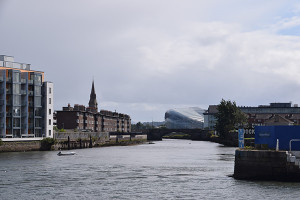
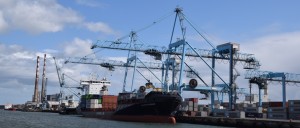
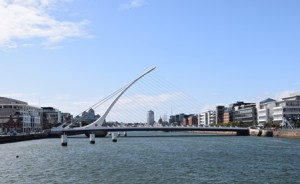
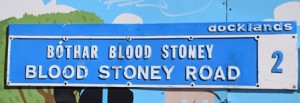
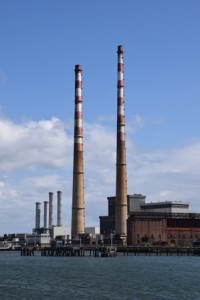
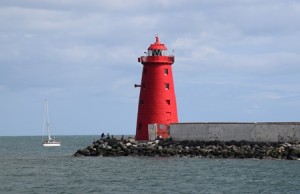
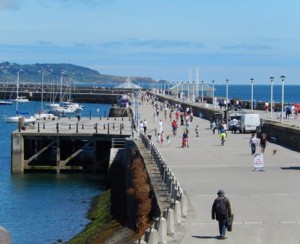
I feel like I was with you on the St. Bridget!
You will be soon!
Fascinating!
Thanks for sharing all this — great! I loved my short visit to Dublin this summer and the water part was gorgeous and interesting, things I had not appreciated.
Thanks Suzanne. The Viking Splash Tour goes right down my street, and we are seriously thinking of doing it one day on the recommendation of you and Harriet!
“There’s nothing like the ocean for putting you in your place!” Indeed! I spent a good bit of my youth on the Pacific coast of California, wrote my first poem about the ocean. Loving my morning tours. -k